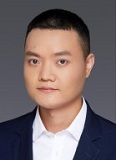
Keynote Speaker

Prof. Weiqiang Han
Zhejiang University, China
The state introduces high-tech personnel. Qiushi Professor, Zhejiang University. September 2012 Former Brookhaven National Laboratory NanoCenter Research fellow. He then served as the director of the Institute of New Energy, Ningbo Institute of Engineering Technology, Chinese Academy of Sciences. In October 2015, I began to work in the School of Materials, Zhejiang University. Research on micro and nano low dimensional materials, lithium ion batteries and catalysts. He has published 225 papers in Nature, Science and other journals. More than 16,000 citations by others (Scopus). As the first author, his work was published in Science in 1997 and became the most frequently cited paper in China in 2002. This work was rated as one of the top ten science and technology news in China in 1998 by the academicians of the k Academy of China and the Academy of Engineering. Participated in the world's first nanomotor research work, in 2003 was named the top ten world science and technology news of the year. He was selected as the 2014-2022 Elsevier China Highly Cited Scholar. He was selected for the Battelle2007 Inventor Award.
Title:
Preparation of Mxenes and Its Application in Lithium/Sodium Batteries
Abstract:
Since its discovery in 2011, MXenes have attracted great interest in the field of energy storage due to their unique combination of characteristics such as metal conductivity, hydrophilicity, large interlayer spacing, and rich surface chemical properties. The most significant characteristics of MXene are its large adjustable interlayer spacing and rich surface chemical properties, which make it different from other two-dimensional materials. We mainly discuss the synthesis and pillaring of MXene ultra-thin layers, the preparation of MXene/transition metal sulfide heterostructures through Lewis acid molten salt etching and subsequent in-situ vulcanization treatment, and their applications in lithium/sodium ion batteries.

Prof. Jianzhong Jiang
Zhejiang University, China
Won the "Bai Person Program" of Chinese Academy of Sciences in 1996; Director, School of Materials Science and Engineering, ZhejiangUniversity, Published in internationally recognized journals including Science, AdvMater, NatureCommun, Nanolett, PNAS, PRL, JACS, AdvFuncMater, Acta Mater, Scientific Reports, APL, PRB, etc.) has published more than 440 papers, and has presided over 973 and 863 projects of the Ministry of Science and Technology, major, key, and general fund projects of the National Natural Science Foundation of China, major international projects of China and Germany, and major and key projects of the Science and Technology Department of Zhejiang Province. He is an adjunct professor or researcher at University of Nevada Reno, USA, Tohoku University, Japan, University of Ulm, Germany, DESY National Laboratory of Synchrotron Radiation, Australia, University of New South West Wales, University of Science and Technology of China, Xiamen University and other universities.
Title:
Pressure-induced structural changes in disordered materials
Abstract:
Due to unique atomic packing structure, disordered materials can exhibit many excellent properties. Pressure, as a thermodynamic parameter, can turn atomic packing and consequently modify properties of materials. Here I talk about pressure-induced structural changes in disordered metallic materials. Some unique phenomena, e.g., amorphous-to-amorphous phase transition, reversible crystallization reaction, will be investigated and their origins are discussed.

Prof. Liguang Wang
Zhejiang University, China
Wang Liguang, researcher of "Bai People Program ", doctoral supervisor, selected as National High-level Talent Program Youth Project (overseas). He obtained his master's degree in Electrochemistry from Harbin Institute of Technology. In 2015, he went to the Advanced Photon Source (APS) synchrotron radiation center line station of Argonne National Laboratory in the United States for a two-year doctoral joint training. Since then, he has been familiar with the application of synchrotron radiation technology in the field of electrochemical energy storage. Mainly engaged in interdisciplinary basic and applied research, involving chemistry, physics, materials and other fields, focusing on synchrotron radiation characterization (spectroscopy and imaging technology) in the field of high energy density lithium-ion battery cathode materials has made some achievements. As first/corresponding author in Nature, Nature Commun., J. Am. Chem. Soc., Adv. Mater. 30 SCI papers have been published in other journals, with a total of more than 3000 citations, and the H-factor is 33. Presided over the National Natural Science Foundation project. Angew. Chem., Adv. Energy Mater., Nano Energy, Small Methods, ACS Appl. Mater. Interfaces, J. Phys. Chem. Lett., Carbon Energy, Chem. Commun., Langmuir and other journals reviewer, Carbon Energy (IF=21.56) the first young editorial board and won the 2022 Outstanding Young Editorial Board award.
Title:
Understanding the degradation mechanisms in high-energy density cathodes via synchrotron X-ray techniques
Abstract:
The progress in electric vehicle (EV) development has heightened the demand for lithium-ion batteries (LIBs) with enhanced energy density and extended cycle life. Within this context, the cathode material assumes a critical role in shaping the overall performance of lithium-ion batteries. To advance the development of the next generation of high-energy-density cathode materials, our research endeavors have systematically unraveled the intricacies of performance degradation mechanisms inherent in layered structure cathodes. This exploration leveraged a sophisticated combination of advanced synchrotron X-ray-based characterization techniques across multiple scales. Our investigation has been transformative, shedding light on the intrinsic correlation between stress-strain dynamics and mechanical degradation within layered cathode materials. Specifically, we discerned that the accrual of lattice strain during lithium extraction and insertion plays a significant role in inducing structural distortion and subsequent performance decay. This pioneering insight has given rise to a novel strategy for structural stress regulation, culminating in the innovative development of ultra-low strain layered cathode materials. This accomplishment is a testament to our meticulous approach to material structure design at the lattice scale, effectively mitigating inherent defects and ushering in a new era of advancements in cathode material research.

Prof. Aimiao Qin
Guilin University of Technology, China
Aimiao Qin is a professor of Guilin University of Technology. She received her Ph.D. in Sun Yat-Sen University. Her primary research interest is in photoelectric functional nanomaterials, biomass carbon energy storage materials and devices, quantum dot fluorescent probes and sensors, etc. She has published more than 100 papers in Adv. Mater., Nano Energy, Inorg. Chem., Cryst. Growth Des., Scientific Report, RSC Advances, Inorg. Chem. Commun., Mater. Lett., Solid State Commun. and other journals. There are more than 50 patents applied for invention, of which 31 have been authorized and one has been transformed into achievements. She has won 3 provincial and ministerial-level science and technology awards. She has hosted/participated in more than 20 scientific research projects, and successfully organized 2 domestic academic conferences.
Title:
Preparation and Application of Flexible Ultrafine Titanium Dioxide Nanowire Optoelectronic Materials
Abstract:
Reducing the nanoscale of the catalyst can obtain a higher comparative area. When the nanoscale is less than a critical value, it will also generate a unique photon effect, thereby further improving the photoelectric performance of catalyst semiconductors. In this report, a synthesis technique was introduced for inducing the formation of TiO2 ultrafine nanowire arrays using carbon quantum dots (CQDs) with hydrothermal method. The synthesized TiO2 nanowires were grown in situ on a flexible Ti substrate. Compared with existing reports, the obtained TiO2 nanowires have made breakthroughs in geometric morphology and optoelectronic properties, and have shown good application potential in photoelectrochemical water resolution hydrogen, organic pollutant degradation, and self driven optoelectronic collaborative wastewater treatment.

Prof. Yang Liu
Huazhong University of Science and Technology, China
Yang Liu, Professor of School of Materials Science and Engineering, Huazhong University of Science and Technology.
Yang Liu is currently a professor of School of Materials Science and Engineering, Huazhong University of Science & Technology, China. He received his PhD in Condensed Matter Physics from CentraleSupélec, Université Paris-Saclay in 2016. Prior to joining the faculty at Huazhong University of Science & Technology in 2021, he was a postdoctoral fellow with Prof. Qing Wang at The Pennsylvania State University. He has published more than 30 first-author or corresponding author papers in Nature, Nature Materials. He has received MRS postdoc award, the runners-up of FECS APS March Meeting Mini Grants, the Postdoctoral Excellence in Research Award. His current research interests lie in physics and engineering of dielectric and ferroelectric polymers and nanocomposites for electronic, electromechanical and energy devices.
Title:
Recent progress on electromechanical coupling effect in ferroelectric polymer and nanocomposites
Abstract:
Low-cost, light weight, flexible relaxor ferroelectric polymers and nanocomposites are a unique member in ferroelectric materials to develop flexible, wearable and biocompatible devices in acoustic sensors, transducers and actuators. In this talk, we first present our discovery of morphotropic phase boundary-like behavior in ferroelectric copolymers which exhibits the state-of-the-art piezoelectric coefficient of -63.5 pC/N. Moreover, we reveal that the relaxor behavior of ferroelectric polymers originates from conformational disorder, which is completely different from classic perovskite relaxors typically characterized by the existence of chemical disorder. We show that chain chirality is essential to the formation of disordered helix conformation arising from local distortions of gauche torsional angles, which consequently give rise to relaxor ferroelectric properties in polymers. We are dedicated to address recent emerging advance in electro-thermal actuation in ferroelectric polymer nanocomposites which show a strain of over 8% and an output mechanical energy density of 11.3 J/cm3 at an electric field of 40 MV/m in the composite, outperforming the benchmark relaxor single-crystal ferroelectrics. The deep insights into ferroelectric polymers and nanocomposites may pave the way towards rational design of the state-of-the-art electronics and energy storage devices.

Prof. Henry Hu
University of Windsor, Canada
The applicant's current research is on materials processing and evaluation of light alloys and composites. His recent fundamental research is focussed on transport phenomena and mechanisms of solidification, phase transformation and dissolution kinetics. His applied research has included development of magnesium automotive applications, cost-effective casting processes for novel composites, and control systems for casting processes. His work on light alloys and composites has attracted the attention of several automotive companies. He has published over 200 articles in refereed international journal and conference proceedings.
Title:
Electrolytic Plasma Oxidation Process for Corrosion Protection of Mg Alloy AM50
Abstract:
Electrolytic plasma oxidation (EPO) has been considered as a new technique to form ceramic coatings on magnesium alloys for corrosion protection. In this study, a magnesium alloy, AM50, was treated by EPO, and the Taguchi experimental analysis method was used to systematically investigate the effects of four factors (treatment time, current density, and concentration of KOH and NaAlO2) with three levels on the thickness and corrosion resistance of the coatings. It was found that treatment time was a major factor affecting the thickness, while the KOH concentration had the most significant effect on the corrosion resistance of the coatings. The phase compositions, thickness and uniformity of the coatings were responsible for the differences of the corrosion resistance of the coatings. With an increase of the KOH concentration, the MgO phase was enriched, and the MgAl2O4 phase was reduced in the coatings. On the other hand, increasing the NaAlO2 concentration resulted in an enrichment of the MgAl2O4 in the coatings. It was also found that the coatings grew towards both their substrates and their external surface, and unevenly distributed sparks lead to non-uniformity in coating thickness.